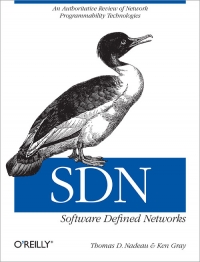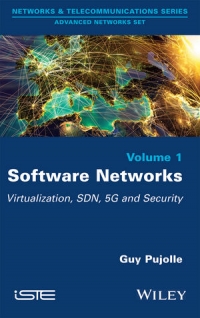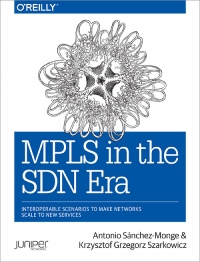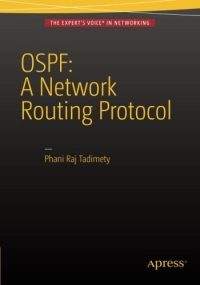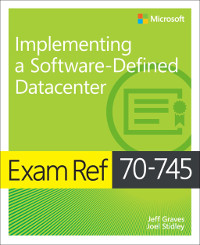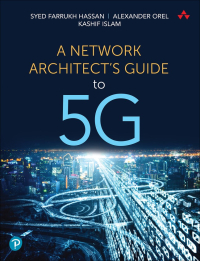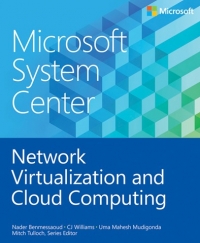SDN: Software Defined Networks
Explore the emerging definitions, protocols, and standards for SDN - software-defined, software-driven, programmable networks - with this comprehensive guide. Two senior network engineers show you what's required for building networks that use software for bi-directional communication between applications and the underlying network infrastructure. This vendor-agnostic book also presents several SDN use cases, including bandwidth scheduling and manipulation, input traffic and triggered actions, as well as some interesting use cases around big data, data center overlays, and network-function virtualization. Discover how enterprises and service providers alike are pursuing SDN as it continues to evolve. ...
Explore the emerging definitions, protocols, and standards for SDN - software-defined, software-driven, programmable networks - with this comprehensive guide. Two senior network engineers show you what's required for building networks that use software for bi-directional communication between applications and the underlying network infrastructure. This vendor-agnostic book also presents several SDN use cases, including bandwidth scheduling and manipulation, input traffic and triggered actions, as well as some interesting use cases around big data, data center overlays, and network-function virtualization. Discover how enterprises and service providers alike are pursuing SDN as it continues to evolve. ...
Software Networks
The goal of this book is to describe new concepts for Internet next generation. This architecture is based on virtual networking using Cloud and datacenters facilities. Main problems concern 1) the placement of virtual resources for opening a new network on the fly, and 2) the urbanisation of virtual resource implemented on physical network equipment. This architecture deals with mechanisms capable of controlling automatically the placement of all virtual resources within the physical network. In this book, we describe how to create and delete virtual networks on the fly. Indeed, the system is able to create any new network with any kind of resource. We will show how this architecture is compatible with new advances in SDN, new high-speed transport protocol like TRILL and LISP, NGN, IMS, Wi-Fi new generation, and 4G/5G networks. Finally, we introduce the Cloud of security and the virtualisation of secure elements (smartcard) that should definitely transform how to secure the Interne ...
The goal of this book is to describe new concepts for Internet next generation. This architecture is based on virtual networking using Cloud and datacenters facilities. Main problems concern 1) the placement of virtual resources for opening a new network on the fly, and 2) the urbanisation of virtual resource implemented on physical network equipment. This architecture deals with mechanisms capable of controlling automatically the placement of all virtual resources within the physical network. In this book, we describe how to create and delete virtual networks on the fly. Indeed, the system is able to create any new network with any kind of resource. We will show how this architecture is compatible with new advances in SDN, new high-speed transport protocol like TRILL and LISP, NGN, IMS, Wi-Fi new generation, and 4G/5G networks. Finally, we introduce the Cloud of security and the virtualisation of secure elements (smartcard) that should definitely transform how to secure the Interne ...
MPLS in the SDN Era
How can you make multivendor services work smoothly on today's complex networks? This practical book shows you how to deploy a large portfolio of multivendor Multiprotocol Label Switching (MPLS) services on networks, down to the configuration level. You'll learn where Juniper Network's Junos, Cisco's IOS XR, and OpenContrail, interoperate and where they don't. Two network and cloud professionals from Juniper describe how MPLS technologies and applications have rapidly evolved through services and architectures such as Ethernet VPNs, Network Function Virtualization, Seamless MPLS, Egress Protection, External Path Computation, and more. This book contains no vendor bias or corporate messages, just solid information on how to get a multivendor network to function optimally. ...
How can you make multivendor services work smoothly on today's complex networks? This practical book shows you how to deploy a large portfolio of multivendor Multiprotocol Label Switching (MPLS) services on networks, down to the configuration level. You'll learn where Juniper Network's Junos, Cisco's IOS XR, and OpenContrail, interoperate and where they don't. Two network and cloud professionals from Juniper describe how MPLS technologies and applications have rapidly evolved through services and architectures such as Ethernet VPNs, Network Function Virtualization, Seamless MPLS, Egress Protection, External Path Computation, and more. This book contains no vendor bias or corporate messages, just solid information on how to get a multivendor network to function optimally. ...
OSPF: A Network Routing Protocol
Learn how routers network using the OSPF (Open Shortest Path First) protocol and unpick Dijkstra's Network Algorithm to see how OSPF performs the calculations to determine the shortest or most appropriate path between two routers. OSPF: A Network Routing Protocol dives deep into the OSPF protocol without sacrificing simplicity in language. All of this is done with running examples and illustrations to clarify concepts and enhance the enjoyment of networking. OSPF: A Network Routing Protocol is an absorbing, comprehensible account of OSPF, including the algorithm which is used for calculating its routes. While OSPF has traditionally been an organizational networking protocol, in these exciting times of Software Defined Networking (SDN), it has assumed an important role in the consolidated data center too. Now that the traditional distinctions between server and network roles are getting blurred, everyone in the data center needs to become familiar with networking and networking proto ...
Learn how routers network using the OSPF (Open Shortest Path First) protocol and unpick Dijkstra's Network Algorithm to see how OSPF performs the calculations to determine the shortest or most appropriate path between two routers. OSPF: A Network Routing Protocol dives deep into the OSPF protocol without sacrificing simplicity in language. All of this is done with running examples and illustrations to clarify concepts and enhance the enjoyment of networking. OSPF: A Network Routing Protocol is an absorbing, comprehensible account of OSPF, including the algorithm which is used for calculating its routes. While OSPF has traditionally been an organizational networking protocol, in these exciting times of Software Defined Networking (SDN), it has assumed an important role in the consolidated data center too. Now that the traditional distinctions between server and network roles are getting blurred, everyone in the data center needs to become familiar with networking and networking proto ...
Exam Ref 70-745 Implementing a Software-Defined DataCenter
Prepare for Microsoft Exam 70-745 - and help demonstrate your real-world mastery of skills needed to build and manage software-defined infrastructure with Windows Server 2016 and System Center 2016 Virtual Machine Manager (SC VMM). Designed for experienced IT professionals ready to advance their status, Exam Ref focuses on the critical thinking and decision-making acumen needed for success at the MCSE level. Focus on the expertise measured by these objectives: Plan and implement System Center Virtual Machine Manager (VMM) core infrastructure; Implement Software-Defined Networking (SDN); Implement software-defined storage; Implement datacenter compute solutions with Virtual Machine Manager (VMM); Secure your software-defined datacenter; Monitor and maintain the software-defined datacenter; Organizes its coverage by exam objectives; Features strategic, what-if scenarios to challenge you; Assumes you have experience with System Center 2012 R2 Virtual Machine Manager and Windows Server ...
Prepare for Microsoft Exam 70-745 - and help demonstrate your real-world mastery of skills needed to build and manage software-defined infrastructure with Windows Server 2016 and System Center 2016 Virtual Machine Manager (SC VMM). Designed for experienced IT professionals ready to advance their status, Exam Ref focuses on the critical thinking and decision-making acumen needed for success at the MCSE level. Focus on the expertise measured by these objectives: Plan and implement System Center Virtual Machine Manager (VMM) core infrastructure; Implement Software-Defined Networking (SDN); Implement software-defined storage; Implement datacenter compute solutions with Virtual Machine Manager (VMM); Secure your software-defined datacenter; Monitor and maintain the software-defined datacenter; Organizes its coverage by exam objectives; Features strategic, what-if scenarios to challenge you; Assumes you have experience with System Center 2012 R2 Virtual Machine Manager and Windows Server ...
A Network Architect's Guide to 5G
As 5G transforms mobile usage and services, network professionals will need to significantly evolve their transport network architectures towards greater sophistication and stronger integration with radio networks, and facilitate transition towards cloud-native 5G mobile core. Until now, however, most 5G guides have foregrounded RF/radio and mobile core innovations, not its implications for data networks. A Network Architects Guide to 5G fills the gap, giving network architects, designers, and engineers essential knowledge for designing and planning their own 5G networks. Drawing on decades of experience with global service providers and enterprise networks, the authors illuminate new and evolving network technologies necessary for building 5G-capable networks, such as segment routing, network slicing, timing and synchronization, edge computing, distributed data centers, integration with public cloud, and more. They explain how 5G blurs boundaries between mobile core, radio access, ...
As 5G transforms mobile usage and services, network professionals will need to significantly evolve their transport network architectures towards greater sophistication and stronger integration with radio networks, and facilitate transition towards cloud-native 5G mobile core. Until now, however, most 5G guides have foregrounded RF/radio and mobile core innovations, not its implications for data networks. A Network Architects Guide to 5G fills the gap, giving network architects, designers, and engineers essential knowledge for designing and planning their own 5G networks. Drawing on decades of experience with global service providers and enterprise networks, the authors illuminate new and evolving network technologies necessary for building 5G-capable networks, such as segment routing, network slicing, timing and synchronization, edge computing, distributed data centers, integration with public cloud, and more. They explain how 5G blurs boundaries between mobile core, radio access, ...
Network Virtualization and Cloud Computing
As businesses move more toward cloud computing, one important factor for success is adopting multi-tenant software-defined networking (SDN) solutions in data centers. Hyper-V Network Virtualization (HNV) is a key enabler for a multi-tenant SDN solution and is essential for implementing a hybrid cloud environment where tenants can bring not only their own IPs, but their entire network topology since the virtualized networks are abstracted from the underlying fabric network. Network virtualization in general and Hyper-V Network Virtualization in particular are relatively new concepts. Unlike server virtualization, which is a mature, widely-understood technology, network virtualization still lacks this kind of broad familiarity. This brief book identifies some key usage and deployment scenarios for cloud computing to provide some deep technical background on the Microsoft SDN solution, enabling IT professionals to quickly learn the internals of HNV, how it works from end to end, and wh ...
As businesses move more toward cloud computing, one important factor for success is adopting multi-tenant software-defined networking (SDN) solutions in data centers. Hyper-V Network Virtualization (HNV) is a key enabler for a multi-tenant SDN solution and is essential for implementing a hybrid cloud environment where tenants can bring not only their own IPs, but their entire network topology since the virtualized networks are abstracted from the underlying fabric network. Network virtualization in general and Hyper-V Network Virtualization in particular are relatively new concepts. Unlike server virtualization, which is a mature, widely-understood technology, network virtualization still lacks this kind of broad familiarity. This brief book identifies some key usage and deployment scenarios for cloud computing to provide some deep technical background on the Microsoft SDN solution, enabling IT professionals to quickly learn the internals of HNV, how it works from end to end, and wh ...
